REAL-WORLD DATA SHOW USE OF ARCALYST STEADILY INCREASED
Treatment choice over time in patients failing aspirin/NSAIDs/colchicine8*


PROPORTIONAL USE OF csDMARDs AND ANAKINRA 2020-2021II:
- csDMARDs: 10% (1/10)
- anakinra: 10% (1/10)
2021*:
- csDMARDs: 3% (1/31)
- anakinra: 13% (4/31)
2022:
- csDMARDs: 5% (2/42)
- anakinra: 5% (2/42)
2022:
- csDMARDs: 3% (1/30)
- anakinra: 0% (0/30)
These real-world data are retrospective and observational in nature. Data should be interpreted within that context, and predictive value is therefore limited. Results are possibly subject to bias due to site experience; generalizability to centers with different experience levels may be affected.
*Failing is defined as patients who had to intensify to higher-line therapies, such as csDMARDs, corticosteroids, anakinra, or ARCALYST. †Reference group is 2020-2021. ‡Of 52 patients starting ARCALYST after aspirin/NSAIDs/colchicine, 5 patients utilized steroids as a short-term bridge prior to starting ARCALYST (2 patients in 2021, 2 patients in 2022, 1 patient in 2023); 4 patients (2 patients in 2021, 2 patients in 2023) utilized anakinra as a short-term bridge prior to starting ARCALYST. §Reference group is 2021. IIPartial year 2021 prior to ARCALYST availability on April 1, 2021. ¶Partial year 2021 after ARCALYST availability after April 1, 2021.**Data censored at last check-in visit.
RESONANCE is the largest US patient registry for recurrent pericarditis. These real-world data are retrospective and observational in nature. Data should be interpreted within that context, and predictive value is therefore limited. Results are possibly subject to bias due to site experience; generalizability to centers with different experience levels may be affected.

Data were collected starting March 2020 until the data cutoff date (July 1, 2024).
*All patients were 12 years of age or older.
†In patients on aspirin/NSAIDs/colchicine, proportion of patients who added/switched to conventional disease-modifying antirheumatic drugs, corticosteroids, anakinra, or ARCALYST during the observation period; data censored at last check-in visit.
‡The aim of the analysis was to look at temporal trends in the management of recurrent pericarditis in real-world clinical practice. RHAPSODY patients were excluded from the analysis to allow for the study of real-world recurrent pericarditis medication class use outside of the clinical trial setting.
Reference: 1. Cremer P, Garshick M, et al. Increased adoption of IL-1 pathway inhibition and the steroid-sparing paradigm shift: temporal trends in recurrent pericarditis treatment from the RESONANCE patient registry. Poster 84412. Presented at: European Society of Cardiology; August 30–September 2, 2024; London, UK.
RESONANCE is a patient registry which collects observational data from real-world practice to better understand the presentation, management, and outcomes of patients with recurrent pericarditis. These data are intended to better inform clinical decision-making and help guide clinical practice to improve the management of patients with recurrent pericarditis.

Data Collection:
Hybrid approach: up to 1-year retrospective data (the year prior to enrollment) were combined with prospective data into a single seamless observation period. The date range for RESONANCE is March 2020 to March 2026.
*Active recurrent pericarditis patients enrolled in the registry defined as: currently under the care of a physician for treatment of recurrent pericarditis at time of enrollment; currently on treatment for
recurrent pericarditis at time of enrollment; having experienced a recurrence in the last 3 years prior to enrollment.
Reference: 1. Cremer P, Garshick M, et al. Increased adoption of IL-1 pathway inhibition and the steroid-sparing paradigm shift: temporal trends in recurrent pericarditis treatment from the
RESONANCE patient registry. Poster 84412. Presented at: European Society of Cardiology; August 30–September 2, 2024; London, UK.
References: 1. Klein AL, Cremer PC, Kafil TS. Recurrent pericarditis: a promising future for IL-1 blockers in autoinflammatory phenotypes. J Am Coll Cardiol. 2023;82(1):41-45. doi:10.1016/j.jacc.2023.05.013 2. Klein A, Cremer P, Kontzias A, et al. Clinical burden and unmet need in recurrent pericarditis: a systematic literature review. Cardiol Rev. 2022;30(2):59-69. doi:10.1097/CRD.0000000000000356 3. Brucato A, Wheeler A, Luis SA, et al. Transition to rilonacept monotherapy from oral therapies in patients with recurrent pericarditis. Heart. 2023;109:297-304. 4. Schwier NC, Luis SA, Hu X, et al. Risk factors associated with recurrence and corticosteroid-associated adverse events in patients with recurrent pericarditis. Value in Health. 2021;24(5)(suppl 1):S67. Abstract PCV5. 5. Chiabrando JG, Bonaventura A, Vecchié A, et al. Management of acute and recurrent pericarditis. J Am Coll Cardiol. 2020;75(1):76-92. 6. Klein AL, Imazio M, Cremer P, et al. Phase 3 trial of interleukin-1 trap rilonacept in recurrent pericarditis. N Engl J Med. 2021;384(1):31-41. 7. ARCALYST. Package insert. Kiniksa Pharmaceuticals; 2021. 8. Cremer P, Garshick M, et al. Increased adoption of IL-1 pathway inhibition and the steroid-sparing paradigm shift: temporal trends in recurrent pericarditis treatment from the RESONANCE patient registry. Poster 84412. Presented at: European Society of Cardiology; August 30–September 2, 2024; London, UK.
Consider Treating Your Patients With ARCALYST For At Least 24 Months to Maintain Prevention of Recurrences‖
Control of recurrent pericarditis requires continued blockade of IL-1 signaling for the duration of disease.7,8
ARCALYST relieves pain and resolves inflammation while on treatment.1
- Absence of abnormal NRS pain scores or CRP levels while on treatment has limited value for predicting future recurrence should treatment be stopped
Duration of treatment relies on understanding the natural history of recurrent pericarditis and clinical experience with ARCALYST.



If prematurely discontinued, ARCALYST may be reinitiated.
In both RW and LTE periods, all patients who reinitiated ARCALYST after a flare experienced resolution2,3,9:
- In the RW period, all patients who had a recurrence (25) reinitiated ARCALYST and experienced resolution of their flare
- In the LTE period, all patients who had a recurrence and reinitiated ARCALYST (6/7) experienced resolution of their flare¶
¶1 patient experienced a recurrence, but did not reinitiate ARCALYST.
Patient and Caregiver Experiences With Recurrent pericarditis and ARCALYST
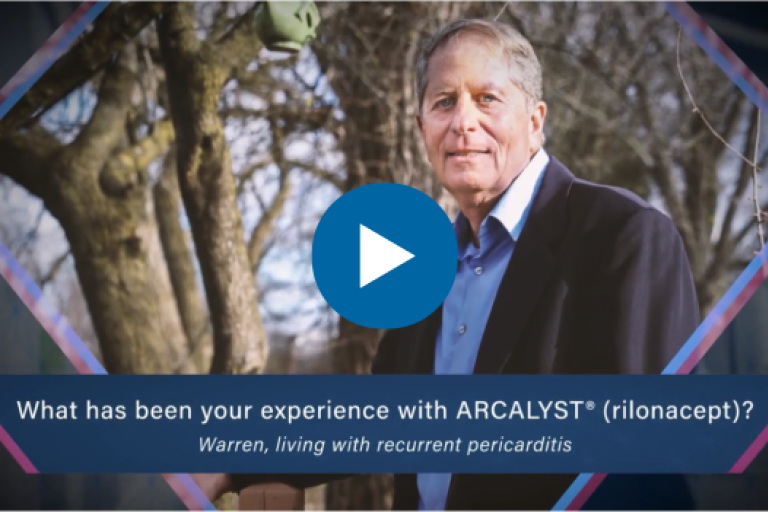
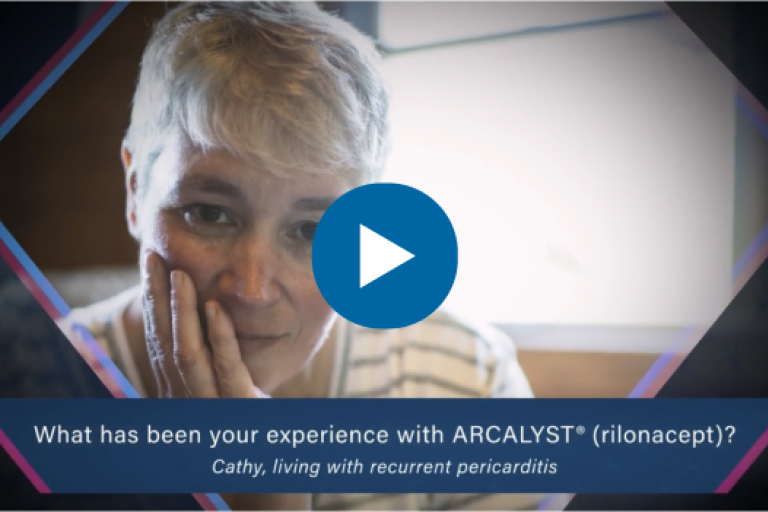
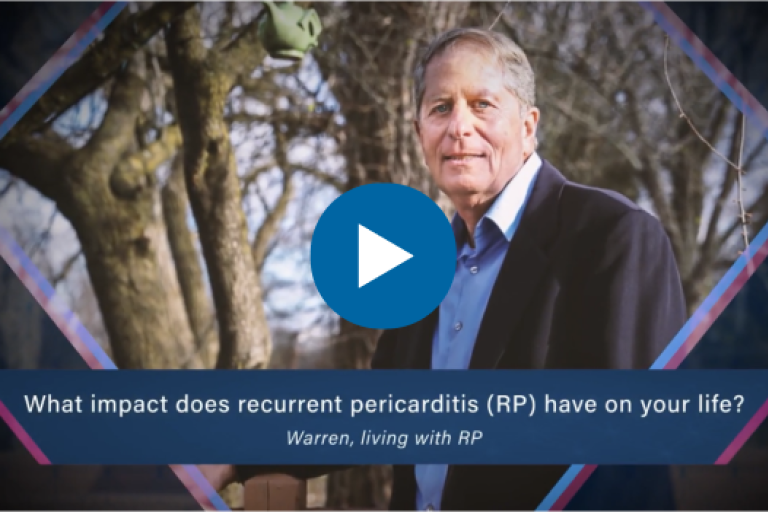

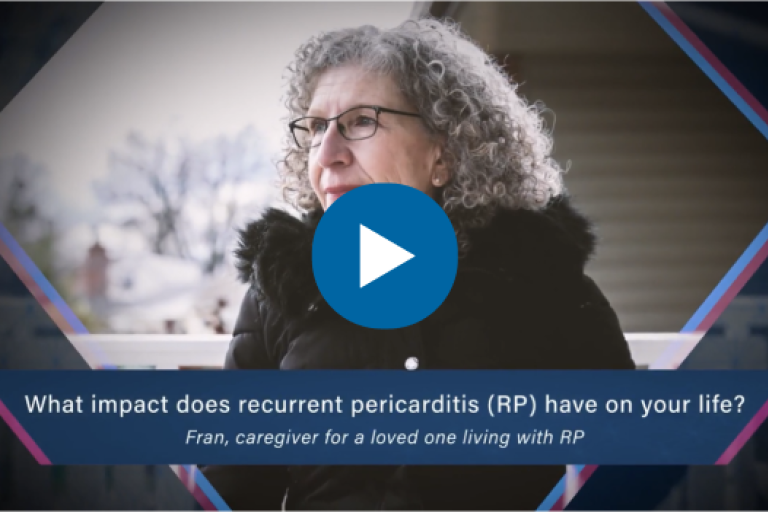
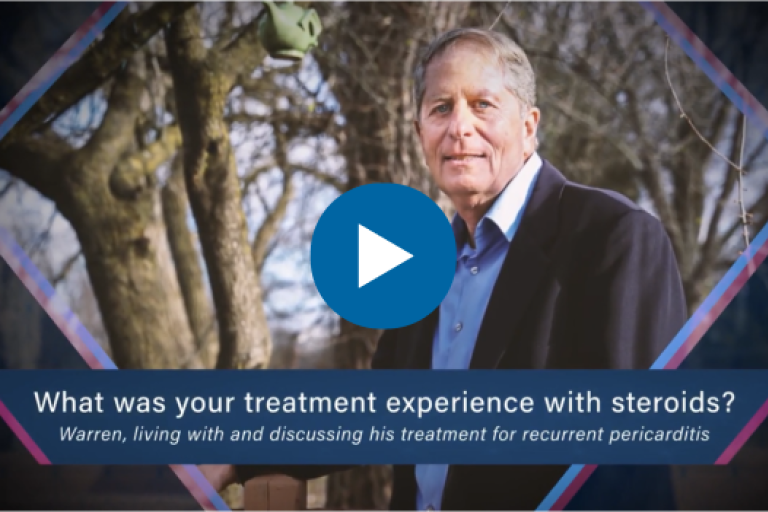
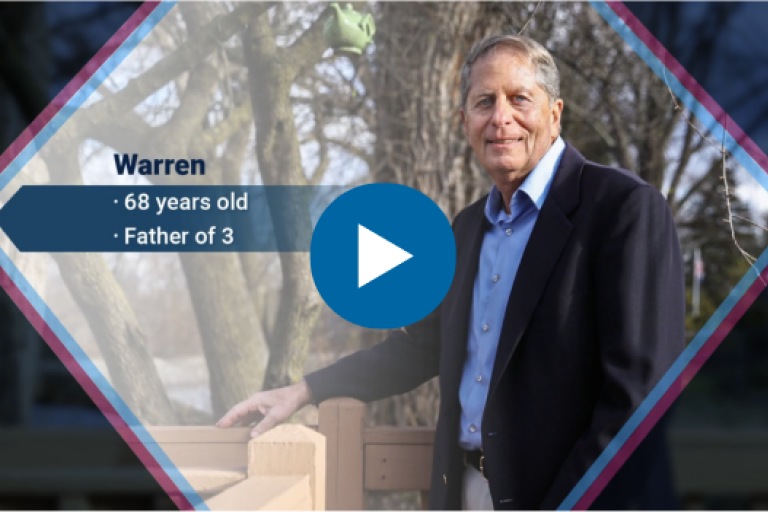
References: 1. ARCALYST. Package insert. Kiniksa Pharmaceuticals. 2. Klein AL, Imazio M, Cremer P, et al. Phase 3 trial of interleukin-1 trap rilonacept in recurrent pericarditis. N Engl J Med. 2021;384(1):31-41. 3. L Imazio M, Klein AL, Brucato A, et al. Sustained Pericarditis Recurrence Risk Reduction With Long-Term Rilonacept. J Am Heart Assoc. 2024;13(6):e032516. doi:10.1161/JAHA.123.032516. 4. Brucato A, Wheeler A, Luis SA, et al. Transition to rilonacept monotherapy from oral therapies in patients with recurrent pericarditis. Heart. 2023;109:297-304. 5. Schwier NC, Luis SA, Hu X, et al. Risk factors associated with recurrence and corticosteroid-associated adverse events in patients with recurrent pericarditis. Value in Health. 2021;24(5)(suppl 1):S67. Abstract PCV5. 6. Imazio M, Klein AL, Brucato A, et al. Sustained Pericarditis Recurrence Risk Reduction With Long-Term Rilonacept. J Am Heart Assoc. 2024;13(6):e032516. doi:10.1161/JAHA.123.032516. 7. Imazio M, Mardigyan V, Andreis A, Franchin L, De Biasio M, Collini V. New developments in the management of recurrent pericarditis. Can J Cardiol. 2023;39(8):1103-1110. doi:10.1016/j.cjca.2023.04.008 8. Lin D, Laliberté F, Majeski C, et al. Disease and economic burden associated with recurrent pericarditis in a privately insured United States population. Adv Ther. 2021;38(10):5127-5143. doi:10.1007/s12325-021-01868-7 9. Data on file. Kiniksa Pharmaceuticals (UK), Ltd. 10. Brucato A, Lim-Watson MZ, Klein A, et al; RHAPSODY Investigators.Interleukin-1 trap rilonacept improved health-related quality of life and sleep in patients with recurrent pericarditis: results from the phase 3 clinical trial RHAPSODY. J Am Heart Assoc. 2022;11(20):e023252. doi:10.1161/JAHA.121.0232526
